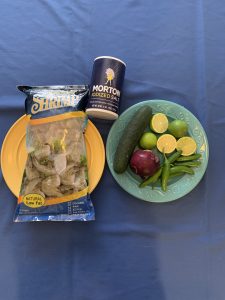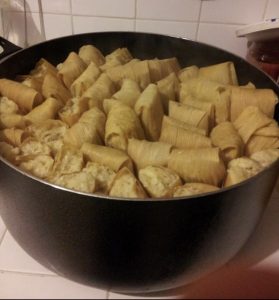
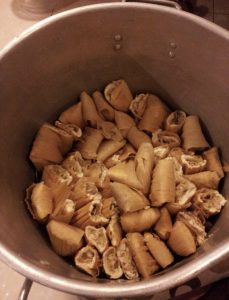
History
The tamale is said to have been created circa 8000 -5000 BC by the indigenous people of Mesoamerica that started in the Mexican region and spread to Guatemala and the rest of Central American (khanacademy.org).
The tamale was created by the Olmecs, Toltecs, Mayans, and Aztecs who considered themselves the people of the corn. They all ate and used tamales for rituals and festivities. It is said that the tamale was created to be a meal on the go as well and used while traveling long distances. Wrapped in corn husks, it was the ideal meal for the hunter, and the indigenous armies as well. In Mexico, the tamale is usually wrapped in a corn husk while in parts of Central America the tamale is wrapped in a plantain or banana leaf, it depends on what is most bountiful in the region (khanacademy.org).
My family’s history of tamales.
Just like millions of Central and South Americans, my family celebrated the holidays with nostalgic foods such as tamales, pozole, menudo, capirotada (bread pudding), buñuelos a (crispy flour, cinnamon, and sugar pastry), horchata a (cold milk, rice, and cinnamon drink), and champurrado a (hot chocolate corn-based drink). However, what every member of my family anticipated for the holidays was the tamales, both beef tamales, and sweet pineapple and raisin tamales. These two-holiday staples were also on our family’s menu for the holidays. The reason for the tamales being the main dish with so many other items being served was because it was nostalgic to my grandparents, my father, and all my aunts and uncles. The reason for the tamale being nostalgic was because my grandparents had twelve children and feeding twelve children required getting creative with food and with rationing, so she would make very small tamales to feed her family of fourteen. For the holidays my grandmother Elvira, just like millions of other mother cooked tamales. However, my grandmother’s tamales were small but packed with so much flavor. Her recipe is one I have not found anywhere else but in my fathers’ family’s kitchens. My grandmother no longer cooks for the holidays because she now is eighty-five years old. Now, my aunts and my mother have taken the responsibility of carrying on with my grandmother’s recipe and cooking for the holidays.
My grandmother’s tamales were made with beef instead of the more popular chicken. However, I prefer the beef over the chicken tamale any day. She served her tamales with a garlicky red salsa and a cup of hot Champurrado. What makes my grandmother’s tamales so nostalgic is the size of the tamale and how she wrapped them. The tamales looked like little pouches and unwrapping them was like opening a small gift. This was very important to me because as a child my siblings and I did not receive any Christmas gifts. The tamales were like our gifts so unwrapping them was meaningful to us. Coming from a large family was economically hard for everyone around the holidays and having something to eat was a blessing.
Now as an adult the tamale preparing responsibility has fallen onto me. My mother Martha can no longer take on the responsibility of making the tamales on her own because she has carpal tunnel syndrome. Although my mother helps me in making the tamales; it is my responsibility to wake up at 4:00 am on December 23rd of every year to buy masa, corn husks and other ingredients for the tamales. From there I drive to my mother’s house where I start preparing everything for the tamales, from washing the pots and corn husks, to cooking the chilies and beef. The process usually takes about 6 to 8 hours but it’s all worth it.
I am glad to carry on the traditions and responsibilities of making my grandmothers’ tamale recipe. I know my grandmother and parents are proud of me for taking on the responsibility. I can confidently say that I have my grandmother technique and recipe down perfectly.
My grandmother’s tamale recipe was based on the taste preference of using beef instead of chicken. She also says that the use of beef over chicken was due to it being more filling and with too many children to feed, and a couple of beef tamales would make for a hardy meal for such a big family.
The tamale is such a diverse dish in the sense that the ingredients used range from region to region in Mexico. Some regions make cheese tamales, others make sweet pineapple and raisin tamales. In other parts of central and south America, the tamale is wrapped in plantain leaves and stuffed with a softer masa, chicken, and vegetables. One tamale all central and south America share is the corn tamale. This type of tamale can be either salty or sweet. The corn tamale is made of fresh corn puree, lard and salt or sugar to taste. This type of tamale is usually served with a slice of salty cheese or sour cream.
I would say I’m a tamale connoisseur because I have eaten all sorts of tamales. I’ve tried 10 different types of Mexican tamales, 4 types of Salvadorian tamales, 1 Guatemalan tamale and hope to continue to try different types of tamales from all Central and South America.
My husband’s family is also very knowledgeable in making tamales. My mother-in-law makes Salvadorian tamales twice a week, every week. Though my husband’s tamale story is different from my story. His mother started making tamales in El Salvador during the 1980’s civil war. During this period much of El Salvador was going through tough times and finding employment was hard. My in-laws decided to make money by selling tamales in factories and mechanic shops. They developed their recipe from what they could remember from their mothers making tamales. With trial and error, they were able to develop one of the tastiest Salvadorian tamales I have ever tasted, and I have tasted a few.
Though I have been in the kitchen helping my mother in law make her tamales several times, I have yet to record her recipe. I feel that it is my responsibility to keep her recipe going as well, for my husband’s sake, since my mother in law will be retiring soon and plans to move to El Salvador.
To make my grandmother’s Tamales, I usually buy 25 pounds of masa, 3 bags of dried corn husks, 15 pounds of chuck beef, 2 bags of dried California chili pods, 6 garlic gloves, ½ tsp of salt, 1/2 cup of Knorr bouillon,1/3 teaspoon of ground pepper, and 1/4 cup of white vinegar. This amount makes about 75 tamales. However, for the class, I will breakdown the recipe to make 25 tamales.
Grandmas Tamales
Ingredients:
- 10 Lbs. Nixtamal Masa
- 1 bag of dried corn husks
- 5 pounds of beef cut into 1-pound chunks
- 1 bag of dried California chili peppers
- 1 bag of dried Guajillo chili peppers
- 1 onion
- 6 garlic cloves
- ½ Knorr bouillion
- 1 tsp of ground pepper
- 1/8 cup of white vinegar
Kitchen tools:
You are going to need the following Kitchen tools: a blender, 15-quart pot, large strainer, a 10-quart pot, a large aluminum tray, a 25-quart steamer pot with a rack inside, 2 tablespoons, an electric mixer, and a roll of aluminum.
Preparation:
First, wash your corn husks and leave them soaking in water overnight so that the corn husks are soft and ready to use the following day. Now that corn husks are ready, drain the water and lay them out on your table. Then start cooking your beef in a 15-quart pot. Cook the beef, fill your pot with approximately 7 quarts of water. Place your beef in the pot add 2 garlic cloves, half onion, ¼ cup Knorr bouyon, ½ of tsp salt and ½ tsp of pepper. Cook until tender. Then remove the beef and let it cool. Once the beef is cold shred the beef. Now you’re ready to make the sauce in a 5-quart pot add 3 quarts water. Add the bag the bags of California and Guajillo peppers, 2 cloves of garlic and boil until soft. Then blend the peppers with 2about 2-3 cups of water, 2 cloves of fresh garlic, ¼ Knorr, and 1/8 cup of vinegar. Blend until you get a watery consistency. Strain the Sause and add it to your shredded beef and stir it so the sauce is evenly distributed. Now pour your Nixtamal Masa onto an aluminum tray and with an eggbeater, mix the masa for about 3-5 minutes. This will make your masa’s consistency fluffy when cooked. Place a 25-quart steamer pot with the rack inside and add 2- quarts of water on a chair next to the table where you will be wrapping your tamales. Now you’re ready to wrap your tamales.
Take a corn husk and feel both sides of the husk, the husk has a smooth and a grainy side. You want to place the grainy side on your hand with the smooth side facing you. Then scoop 2 tablespoons of masa onto the smooth side of the husk and spread evenly. Then scoop a tablespoon of beef and place it in the middle of the masa. Then roll one corner of the corn husk toward the other side of the husk, roll into a cone shape. You should have a long strand of corn husk at the bottom. Take the bottom of the husk and fold upward. You should end up with a rectangle shape tamale with one side open. Place each tamale into the pot with the opening face up. Do this as your wrapping each tamale. Once you are done place corn husks on top of your tamales, inside the pot and cover the top of the pot with aluminum foil. This will help in the steaming process so that your tamales are evenly cooked and moist. The husks help the steamer retain water as vapor and will cook the masa. Place your pot on the stove and cook on high until the water boils and you see steam. Then bring down the heat to low and cook for 2 hours. Make sure that the water does not dry, or your tamales will burn. Once the two hours are over, turn off the flame and let the tamales cool before you can serve your tamales.
My family makes a green tomatillo salsa to serve with their tamales. Here is to make the salsa verde.
Salsa Verde:
• 1- pound of green tomatillos
• 2 serrano peppers
• 1- clove of garlic
• 1- Cilantro
• ½ tsp Salt
• 1/8 tsp pepper
• 1/8 onion
First, add 1-quart of water to a 5-quart saucepan and add the tomatillos, serrano peppers, and onion to the water and bring to a boil. Boil until both the tomatillos and peppers are soft. Then pour the tomatillos and serrano peppers into a blender and add 1 clove of garlic and salt and pepper. Blend for 15 seconds or until it’s a watery consistency. Pour the sauce into a bowl and chop about 1/8 cup of cilantro and 1/8 onion and add these to the sauce. Now you are ready to eat your tamales with salsa Verde.
Photos:
The photographs posted are of both Mexican and Salvadorian tamales and the tamale-making process. Here you can see my mother in law making her delicious Salvadorian tamales. I decided to include pictures of her making her chicken tamales because it is very meaningful to her that I share her family’s traditions. I must say that making her Salvadorian chicken tamales is much more complicated than making the Mexican tamales. She was thrilled to know that I included her tamale traditions in my assignment. She told me that she would not mind sharing her recipe, but it was so complex to put into writing, so I decided to share my family’s Mexican tamale recipe.


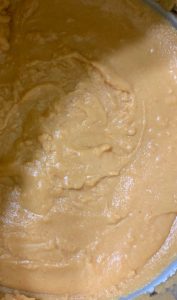
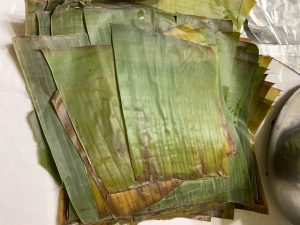
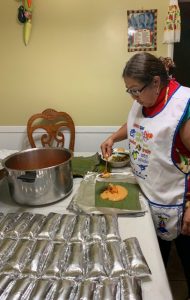
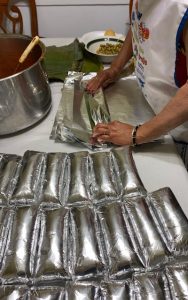

References
Merguez- Sharpnack, Yvette. Tamal Dough (Masa para Tamales) +video. November 25, 2019
https://muybuenocookbook.com/tamal-dough-masa-para-tamales/
https://en.wikipedia.org/wiki/Nahuatl
https://en.wikipedia.org/wiki/Champurrado
Dr. Kilroy-Ewbank, Lauren. Khan academy Mesoamerica, an introduction
https://www.khanacademy.org/humanities/art-americas/beginners-guide-americas/a/mesoamerica-an-introduction
https://www.bonappetit.com/story/what-are-tomatillos
Cartwright, Mark. Ancient History Encyclopedia, Toltec Civilization. April 27, 2018.
https://www.ancient.eu/Toltec_Civilization/
https://www.history.com/topics/ancient-americas/maya
https://www.ancient.eu/Olmec_Civilization/
https://www.britannica.com/topic/Aztec
ENCYCLOPÆDIA BRITANNICA
https://www.britannica.com/place/El-Salvador/Civil-war
https://en.wikipedia.org/wiki/Capirotada
https://www.isabeleats.com/mexican-bunuelos/
https://en.wikipedia.org/wiki/Guajillo_chili
https://wholespice.com/blog/california-red-chile/https://wholespice.com/blog/california-red-chile/


